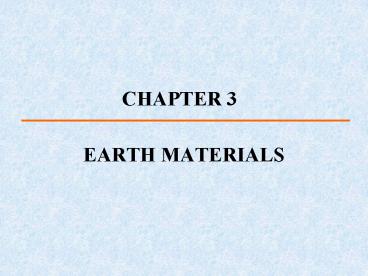EARTH MATERIALS - PowerPoint PPT Presentation
1 / 31
Title:
EARTH MATERIALS
Description:
Clastic (made of clasts = fragments) Silica. Lime. Chemical (Coarse) Sand ... Fine-grained clastic rocks and limestone in humid region; very weak rocks (shale) ... – PowerPoint PPT presentation
Number of Views:27
Avg rating:3.0/5.0
Title: EARTH MATERIALS
1
EARTH MATERIALS
2
Review Plate Tectonics
- What is the key figure from Chapter 2?
A
B
D
C
3
Importance of Rocks Minerals
4
Basic Chemistry Review (1)
- All matter, including minerals and rocks, made of
atoms - Atom structure Nucleus (proton and neutron) and
surrounding electrons - Atomic number The unique number of protons in an
elements nucleus - Atomic mass number The sum of the number of
protons and neutrons - Isotopes same of protons, but differing
neutrons
5
Basic Chemistry Review (2)
6
Earth Materials - Elements
- Only Silly Asses In College Study Past Midnight
- Oxygen
- Silicon
- Aluminum
- Iron
- Calcium
- Sodium
- Potassium
- Magnesium
(0)
(-)
7
Mineral Definitive Properties
- Compounds of elements
- Quartz (SiO2)?
Coal (C)?
Diamond (C)?
Ice (H2O)?
8
Rock-Forming Mineral Groups
9
Rocks
10
The Rock Cycle
- Start anywhere!
- Igneous (primary)
11
The Rock Cycle
- Start anywhere!
- Igneous (primary)
- Weathering and erosion
- Sediments
- Sed. Rocks
- Meta. Rocks (secondary)
- Note alternate paths
12
Igneous Rocks
13
Igneous Rock Texture (1)
- Dictated by the rates of magma cooling
- The rates of cooling are slower beneath the
surface, much faster near or at the surface - The slower the magma cools, the coarser the
mineral particles in igneous rocks - Igneous rocks formed from two stages of cooling
have distinctive, different-sized particles We
have words for that!
14
Igneous Rock Composition
- Depending on the composition of magma
- Felsic Silica rich, typically related to
continental crust - Intermediate Commonly associated with convergent
boundaries along the rim of Pacific - Mafic Silica poor, usually related to the
oceanic crust - Usually characterized by color felsic light
and mafic dark
15
Igneous Rocks
Light(Si-rich)
Dark(Si-poor)
Intermediate
Basalt
Fine (Volcanic/ extrusive)
Andesite
(Rhyolite)
Granite
(Diorite)
(Gabbro)
Coarse (Plutonic/ intrusive)
16
Sediments
- Particle Size
- Very fine (Clay)
- Fine (Silt)
- Moderate (Sand)
- Coarse (Pebbles)
- Very coarse (Cobbles, boulders)
- Dissolved materials (leached from soils)
17
Sedimentary Rocks
Claystone
Siltstone
Sandstone
Conglomerate
Shale (mudstone)
Chert
(Sinter)
Limestone
(Travertine)
18
Sedimentary Structure and Environment
- Stratification layering, evidence of process
- Cross-bedding Movement direction of ancient
currents - Fossil content Environment setting (continental,
marine, or transitional) - Fine-grained clastic rocks and limestone in humid
region very weak rocks (shale) causing
environmental problems
19
Metamorphic Rocks
20
Metamorphic Rock Texture
- Foliation Preferred alignment of platy mineral
particles - Slaty, schistosity, gneissic banding
- Typically classified by texture Slate, schist,
gneiss - Nonfoliated Random arranged and interlocked
mineral particles - Fine-grained, coarse-grained
- Typically classified by composition Marble,
quartzite
21
Metamorphic Rocks
Slate
Schist
Gneiss
Granite
Quartzite
Marble
(Greenstone)
22
Rock Occurrence
- What you see isnt what you get!
23
Surface rock distribution
- Rocks are where its at!
- 1872 Mining Law?
24
Fundamental Stratigraphic Principles
- Three fundamental principles in understanding the
relationships of rocks and Earth history - The law of crosscutting relationships rock is
younger than the ones that it cuts - The law of original horizontality sedimentary
rock layers nearly horizontal under normal
conditions - The law of superposition rocks become
progressively younger towards the top in an
undisturbed and undeformed rock sequence
25
Rocks and Environment
26
Rock Structure Strength
27
Rock Structure (1)
- Brittle deformation Fractures, joints, and
faults - Conduits for fluids, possibly pollutants
- Weak surfaces for landslide, earthquake, and
failures of infrastructure
28
Rock Structure (1)
- Brittle deformation Fractures, joints, and
faults - Weak surfaces for landslide, earthquake, and
failures of infrastructure
29
- Ductile deformation Folds
- Mountainous terrain
30
Rock Structure (2)
- Unconformity Contact of rock units representing
geologic time gap - Types nonconformity, angular unconformity, and
disconformity - Clues for ancient geologic environment
31
Applied and Critical Thinking Topics
- What rock type is most likely to cause
environmental problems (groundwater, slope
stability, foundation failure)? - Granite
- Sandstone
- Shale
- Gneiss
- Marble































